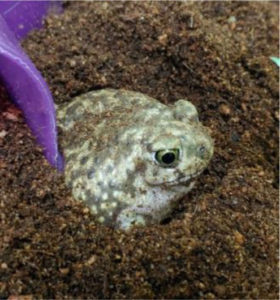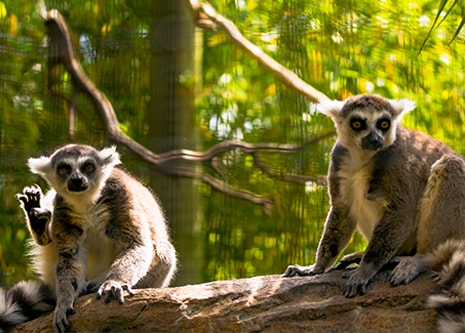
- VisitSupport Happy HollowDONATE TODAYExploreSupport Happy HollowDONATE TODAYLearnSupport Happy HollowDONATE TODAYSupportToday’s Hours: CLOSEDEducation Ambassadors
Couch's Spadefoot Toad

Scientific Name: Scaphiopus couchii
Family: Pelobatidae
Order: Anura
Class: Amphibia
Range: Southwest USA through Baja California & Mexico
Habitat: Desert and arid regions
Lifespan: 13 years for females, 10 years for maleWhat do they look like?
Couch’s spadefoot toads are about 2.25 to 3 inches long with greenish backs and short, fat, toad-like bodies. They are sexually dichromatic and dimorphic, meaning the more greenish males are uniformly colored, while the larger females are covered with an irregular network of blotches of black, brown, or dark green. Spadefoots are not true toads and can be distinguished by their catlike eyes with vertical pupils, the single black, sharp-edged “spade” on each hind foot, teeth in their upper jaw, and smoother skin.How do they behave?
Adults are nocturnal; juveniles have variable activity. They are terrestrial burrowers, digging themselves backwards in loose sandy soil using the spades on their hind feet. Spadefoots spend about 8-10 months during the dry season estivating underground and are cued to emerge when they detect low frequency sound or vibration caused by rainfall or thunder. They are drought-adapted and highly resistant to dehydration but can lose over half of their body weight due to evaporation. They absorb water from the surrounding soil during their period of dormancy.What’s on the menu?
In the wild, adults are carnivorous, eating beetles, termites, ants, grasshoppers, crickets and spiders. Adults can eat up to 55% of their body weight, which can be enough food to last for a year. They survive these extensive periods of time spent in underground estivation by reducing their metabolic rate to about 20-30% of their average resting rate with intermittent breathing to minimize water vapor loss. At the Zoo, they are fed [insert official diet].How are they born?
Couch’s spadefoot toads emerge from their burrows to spawn in temporary ponds created by the onset of summer monsoon season. Upon emergence, males attract females with calls that sound like the bleating of a sheep or goat. Females may lay as many as 3,000 eggs and to ensure the best chance for survival, eggs can hatch in as quickly as 15 hours. Tadpoles are usually herbivorous, feeding on algae and other plant material. However, if water levels fall too low, larger tadpoles will turn carnivorous and prey on their smaller fellows to give them a better chance of surviving and completing metamorphosis.What you should know about them?
Like other spadefoots, the Couch’s produces irritating skin secretions that likely deter predators and can cause sneezing, running nose, and watery eyes in humans. Other closely related spadefoot species have been reported to have secretions that smell like peanut butter.Conservation Connection
The Couch’s Spadefoot Toad’s conservation status is currently listed by the International Union for Conservation of Nature (IUCN) as Least Concern. However, they are considered imperiled in California and critically imperiled in Colorado due to significant habitat loss. Urban development and irrigated agriculture have destroyed habitat in areas where spadefoots were once abundant. You can help spadefoot toads by not supporting the illegal pet trade of California natives and doing your research on which amphibians make appropriate pets.
Zoo on the Hill
Located across from the Keep-Around Carousel is the Zoo on the Hill. Learn about wildlife up close during daily meet-and-greets, leap like a lemur on the playground, brush and feed the goats,, or take a peek inside Doc’s Critter Care building and the Ranch House. Double-H Ranch features a combination of animal exhibits, including giant anteaters and red ruffed lemurs, as well chickens and domesticated animals that are docile enough to touch.
See Animals
Zoo in the Hollow
Follow the crooked bamboo pathway down into the hollow and visit with some of the most amazing animals in the world. Where else in San José can you get up close to a stunning jaguar, lemur, meerkat or American alligator? Happy Hollow is dedicated to helping save species and preserve wildlife for future generations by participating in Species Survival Plan programs through the Association of Zoos and Aquariums.
See AnimalsVisit Us Today
Plan an unforgettable experience at San Jose’s family-friendly park and zoo.
more info